
Styphelia adscendens, commonly known as golden heath, is a species of flowering plant in the heath family Ericaceae and is endemic to south-eastern Australia. It is a prostrate or low-lying shrub with lance-shaped leaves and cream-coloured, pale yellowish-green or reddish flowers arranged singly or in paris in leaf axils.

Styphelia sieberi, commonly known as prickly beard-heath, is a species of flowering plant in the heath family Ericaceae and is endemic to south-eastern continental Australia. It is an erect, densely-branched shrub with oblong to more or less egg-shaped leaves with the narrower end towards the base, and white, tube-shaped flowers arranged singly in upper leaf axils.

Styphelia pendula is a species of flowering plant in the heath family Ericaceae and is endemic to the south-west of Western Australia. It is an erect, straggling shrub with oblong leaves and white, tube-shaped flowers that are bearded inside.
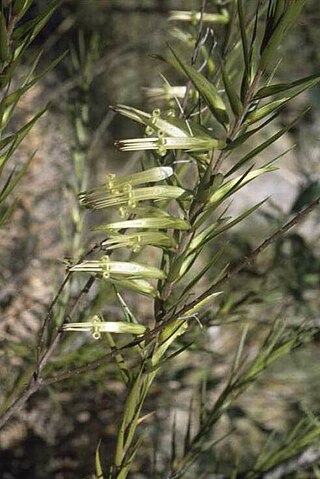
Styphelia longifolia, commonly known as long-leaf styphelia, is a species of flowering plant in the heath family Ericaceae and is endemic to New South Wales. It is an erect shrub with more or less lance-shaped leaves and pale green or yellow flowers arranged singly in leaf axils.

Styphelia mutica, commonly known as blunt beard-heath, is a species of flowering plant in the heath family Ericaceae and is endemic to eastern Australia. It is an erect, straggling shrub with egg-shaped leaves with the narrower end towards the base, and small numbers of white, tube-shaped flowers that are densely bearded inside.
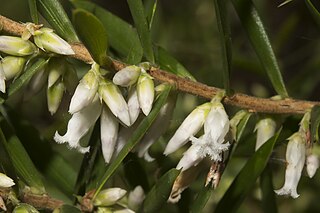
Styphelia propinqua is a species of flowering plant in the heath family Ericaceae and is endemic to the south-west of Western Australia. It is an erect, rigid shrub with linear leaves and white tube-shaped flowers that are bearded inside.

Leucopogon collinus, commonly known as fringed beard-heath, is a species of flowering plant in the heath family Ericaceae and is endemic to south-eastern Australia. It is a slender, erect or spreading shrub with narrowly lance-shaped leaves, and white, tube-shaped, bearded flowers.

Styphelia cuspidata is a species of flowering plant in the family Ericaceae and is endemic to the central Queensland coast. It is a shrub with densely hairy young branchlets, egg-shaped to lance-shaped leaves with the narrower end towards the base, and white, bell-shaped flowers that are bearded inside.

Styphelia deformis is a species of flowering plant in the heath family Ericaceae and is endemic to eastern coastal Australia. It is a bushy shrub with narrowly egg-shaped leaves, and white, tube-shaped flowers.
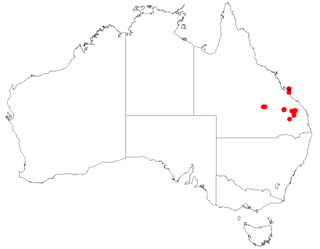
Styphelia flexifolia is a species of flowering plant in the family Ericaceae and is endemic to south-east Queensland. It is a rigid shrub with many softly-hairy branchlets, crowded, sharply-pointed linear to lance-shaped leaves, and small, white, bell-shaped flowers that are bearded inside.

Leucopogon glabellus is a species of flowering plant in the family Ericaceae and is endemic to the south-west of Western Australia. It is an erect, glabrous shrub with slender branchlets, heart-shaped to lance-shaped leaves, and cylindrical spikes of white flowers.
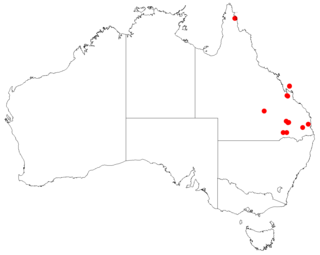
Styphelia imbricata is a species of flowering plant in the family Ericaceae and is endemic to south-east Queensland. It is an erect shrub with glabrous branches, crowded, often overlapping, egg-shaped leaves, and white, bell-shaped flowers that are bearded inside.

Leucopogon interruptus is a species of flowering plant in the family Ericaceae and is endemic to the southwest of Western Australia. It is a spreading, glabrous shrub with oval to oblong leaves crowded at the ends of branches, and many small, white, tube-shaped flowers that are bearded inside.
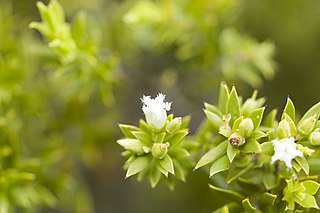
Styphelia leptospermoides is a species of flowering plant in the heath family Ericaceae and is endemic to eastern Australia. It is an erect, bushy shrub with elliptic to lance-shaped or oblong leaves, and white, tube-shaped flowers usually arranged singly in upper leaf axils.

Styphelia margarodes is a species of flowering plant in the heath family Ericaceae and is endemic to near-coastal areas of eastern Australia. It is an erect, spreading shrub with egg-shaped leaves with the narrower end towards the base, and small numbers of white, tube-shaped flowers usually arranged singly or in pairs in upper leaf axils.
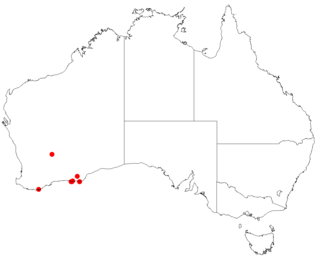
Styphelia multiflora is a species of flowering plant in the family Ericaceae and is endemic to the southwest of Western Australia. It is a rigid shrub with crowded, sharply-pointed, linear to lance-shaped leaves, and white, tube-shaped flowers usually in groups in leaf axils.

Styphelia rotundifolia is a species of flowering plant in the heath family Ericaceae and is endemic to the south of Western Australia. It is an erect, bushy shrub with round or egg-shaped leaves, the narrower end towards the base, and white, tube-shaped flowers arranged in leaf axils in groups of 2 or 3.
Styphelia striata is a species of flowering plant in the heath family Ericaceae and is endemic to the south of Western Australia. It is an erect to spreading shrub with egg-shaped leaves and white, tube-shaped flowers arranged in dense spikes on the ends of branches and in upper leaf axils.
Styphelia compacta is a species of flowering plant in the heath family Ericaceae and is endemic to the south-west of Western Australia. It is a widely spreading or prostrate, much-branched shrub with egg-shaped leaves or lance-shaped leaves with the narrower end towards the base, and red flowers arranged in leaf axils.
Styphelia prostrata is a species of flowering plant in the heath family Ericaceae and is endemic to the south-west of Western Australia. It is a low, spreading or prostrate shrub with linear leaves and red, tube-shaped flowers that are bearded inside.
















